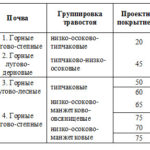UDC 631.48; 581.54
Alichaev M.M., Sultanova M.G., Musalaeva P.D. DIFFERENTIATION OF SOIL PROCESSES BY STAGES OF THEIR DEVELOPMENT IN THE REGIONS OF THE ARID CLIMATE ZONE // Arid Ecosystems. 2022. Vol. 28. № 4 (93). P. 46-54. | PDF
The modern processes of manifestation of the stages of desertification and arid degradation and the dynamics of their development depending on soil fertility in arid conditions are considered on the example of the regions of the Western Caspian – the Tersko-Kuma lowland and the Terek Delta. The development of degradation processes proceeds in two stages, fundamentally different in content and scale of territorial distribution.
The first stage – natural degradation — originates from the time of the development of soil formation processes in the Holocene as one of the indispensable elements of the functioning of living organisms on the Earth’s surface. The natural dynamics of degradation processes proceeds with the formation of an equilibrium state of soil formation with the formation of certain types of soils of a full-profile structure. Depending on the conditions of soil formation characteristic of the degradation direction, such as salinization, pollution, salinity of soils at different stages of their development, salt marshes, salt flats, sandy and clay deserts are formed. The development of these soil properties in natural conditions continues at the present time, their evolution proceeds, starting in the Holocene epoch (Akaev, 1996).
On the second stage the dynamics of arid degradation and desertification is caused by anthropogenic impact, radically different from the indicators of natural degradation. As a result of the increased anthropogenic impact, the natural state of the soil cover is replaced by an unstable secondary one in artificial conditions. The measures contributing to the formation of new directions of soil formation include: the expansion of irrigated land areas in the Terek Delta, the Tersko-Kuma lowland and in other regions, the vulnerability of developed soils to natural salinization phenomena, wind erosion and degradation.
Keywords: stages of soil origination, Holocene differentiation, anthropogenic differentiation, fertility, halophytes, arid degradation, geological time periods, historical time periods.
DOI: 10.24412/1993-3916-2022-4-46-54
EDN: XRHRDC




